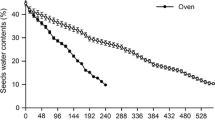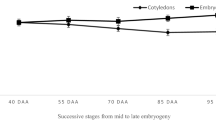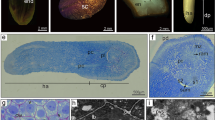Abstract
Cytological and physiological changes were studied in orthodox maize (Zea mays L.) embryos following the acquisition of cryotolerance to liquid nitrogen during seed development. It was found that the embryonic cells at radicle portion were hydrated at all stages investigated, but those at early stages contained fully functional organelles, which disappeared at last developmental stages, and reserve materials accumulated intensively during seed development. Total soluble sugar content in the embryos had a steady rise on fresh weight and moisture weight basis; meanwhile, soluble and heat-stable proteins increased progressively in their number and contents as embryos matured. These cytological and biochemical changes had good correspondence with acquisition of cryotolerance in maize embryos.






Similar content being viewed by others
Abbreviations
- DAP:
-
Days after pollination
- W50FS :
-
The upper limit of moisture content allowing 50% postthaw embryos to survive
References
Bartels D, Singh M, Salamini F (1988) Onset of desiccation tolerance during development of the barley embryo. Planta 175:485–492. doi:10.1007/BF00393069
Berjak P, Pammenter NW (2008) From Avicennia to Zizania: seed recalcitrance in perspective. Ann Bot (Lond) 101:213–228. doi:10.1093/aob/mcm168
Bernac P, Horbowicz M, Downer SM, Dickerman AM, Smith ME, Obendore RL (1997) Raffinose accumulation related to desiccation tolerance during maize (Zea mays L.) seed development and maturation. J Plant Physiol 150:481–488
Bewley JD, Black M (1994) Seeds, physiology of development, germination. Plenum, New York
Black M, Corbineau F, Gee H, Côme D (1999) Water content, raffinose and dehydrins in the induction of desiccation tolerance in immature wheat embryos. Plant Physiol 120:463–471. doi:10.1104/pp.120.2.463
Blackman SA, Wettlaufer SH, Obendorf RL, Leopold AC (1991) Maturation proteins associated with desiccation tolerance in soybean. Plant Physiol 96:868–874. doi:10.1104/pp.96.3.868
Blackman SA, Obendorf RL, Leopold AC (1992) Maturation proteins and sugars in desiccation tolerance of developing soybean seeds. Plant Physiol 100:225–230. doi:10.1104/pp.100.1.225
Bochicchio A, Vazzana C, Raschi A, Bartels D, Salamini F (1988) Effects of desiccation on isolated embryos of maize. Onset of desiccation tolerance during development. Agronomie 8:29–36. doi:10.1051/agro:19880104
Bochicchio A, Vazzana C, Velasco R, Singh M, Bartels D (1991) Exogenous ABA induces desiccation tolerance and leads to the synthesis of specific gen transcripts in immature embryos of maze. Maydica 39:11–16
Bochicchio A, Vernieri P, Puliga S, Balducci F, Vazzana C (1994) Acquisition of desiccation tolerance by isolated maize embryos exposed to different conditions: the questionable role of endogenous abscisic acid. Physiol Plant 91:615–622. doi:10.1111/j.1399-3054.1994.tb02996.x
Bradford MM (1976) A rapid and sensitive method for the quantitation of microgram quantities of protein utilizing the principle of protein-dye binding. Anal Biochem 72:248–254. doi:10.1016/0003-2697(76)90527-3
Brown MJ, Hor YL, Greenwood JS (2001) Reserve accumulation and protein storage vacuole formation during development of recalcitrant seeds of Durio zibethinus L. Seed Sci Res 11:293–303
Buitink J, Leprince O (2004) Glass formation in plant anhydrobiotes: survival in the dry state. Cryobiology 48:215–228. doi:10.1016/j.cryobiol.2004.02.011
Chen Y, Burris JS (1990) Role of carbohydrates in desiccation tolerance and membrane behaviour in maturing maize seed. Crop Sci 30:971–975
Cordova-Tellez L, Burris JS (2002) Alignment of lipid bodies along the plasma membrane during the acquisition of desiccation tolerance in maize seed. Crop Sci 42:1982–1988
Crèvecoeur M, Deltour R, Bronchart R (1976) Cytological study on water stress during germination of Zea mays. Planta 132:31–41. doi:10.1007/BF00390328
Crowe JH, Crowe LM, Carpenter JF, Wistrom CA (1987) Stabilization of dry phospholipids bilayers and proteins by sugars. Biochem J 242:1–10
Crowe JH, Hoekstra FA, Crowe LM (1992) Anhydrobiosis. Annu Rev Physiol 54:579–599. doi:10.1146/annurev.ph.54.030192.003051
Daws MI, Pritchard HW (2008) The development and limits of freezing tolerance in Acer pseudoplatanus fruits across Europe is dependent on provenance. Cryo Lett 29:189–198
Dodd MC, van Staden JV, Smith MT (1989) Seed development in Podocarpus henelii: an ultrastructural and biochemical study. Ann Bot (Lond) 64:297–310
Fairbairn NJ (1953) A modified anthrone reagent. Chem Ind 31:72–86
Farrant JM, Walters C (1998) Ultrastructural and biophysical changes in developing embryos of Aesculus hippocastanum in relation to the acquisition of tolerance to drying. Physiol Plant 104:513–524. doi:10.1034/j.1399-3054.1998.1040401.x
Huang H (2008) Analysis on reactive oxygen species scavenging enzymes and proteome associated with changes of desiccation tolerance of maize seeds. Ph.D. thesis of Graduate School, Chinese Academy of Sciences, Beijing, China
Iljin WS (1957) Drought resistance in plants and physiological processes. Annu Rev Plant Physiol 8:257–274. doi:10.1146/annurev.pp 08.060157.001353
Isaaca C, Mycock D (1999) Ultrastructural effects of early imbibition and cryostorage on Zea mays L. root meristems. Cryo Lett 20:183–192
Jitsuyama Y, Suzuki T, Fujikawa S (2002) Sucrose incubation increases freezing tolerance of asparagus (Asparagus officinalis L.) embryogenic cell suspensions. Cryo Lett 23:103–112
Klein S, Pollock B (1968) Cell fine structure of developing lima bean seeds related to seed desiccation. Am J Bot 55:658–672. doi:10.2307/2440523
Leprince O, Bronchart R, Deltour R (1990) Changes in starch and soluble sugars in relation to the acquisition of desiccation tolerance during maturation of Brassica campestris seed. Plant Cell Environ 13:539–546. doi:10.1111/j.1365-3040.1990.tb01070.x
Lin C, Guo W, Everson E, Thomashow MF (1990) Cold acclimation in Arabidopsis and wheat. A response associated with expression of related genes encoding ‘boiling-stable’ polypeptides. Plant Physiol 94:1078–1083. doi:10.1104/pp.94.3.1078
Nagao M, Arakawa K, Takezawa D, Fujikawa S (2008) Long- and short-term freezing induce different types of injury in Arabidopsis thaliana leaf cells. Planta 227:477–489. doi:10.1007/s00425-007-0633-9
Ooms JJJ, Wilmer JA, Karssen CM (1994) Carbohydrates are not the sole factor determining desiccation tolerance in seeds of Arabidopsis thaliana. Physiol Plant 90:431–436. doi:10.1111/j.1399-3054.1994.tb08798.x
Pammenter NW, Berjak P (1999) A review of recalcitrant seed physiology in relation to desiccation- tolerance mechanisms. Seed Sci Res 9:13–37
Perdomo A, Burris JS (1998) Histochemical, physiological and ultrastructural changes in the maize embryo during artificial drying. Crop Sci 38:1236–1244
Pomeroy MK, Siminovitch D (1971) Seasonal cytological changes in secondary phloem parenchyma cells in Robinia pseudoacacia in relation to cold hardiness. Can J Bot 49:787–800. doi:10.1139/b71-118
Pritchard HW, Grout BWW, Short KC (1986a) Osmotic stress as a pregrowth procedure for cryopreservation. 1. Growth and ultrastructure of sycamore and soybean cell suspensions. Ann Bot (Lond) 57:41–48
Pritchard HW, Grout BWW, Short KC (1986b) Osmotic stress as a pregrowth procedure for cryopreservation. 3. Cryobiology of sycamore and soybean cell suspensions. Ann Bot (Lond) 57:379–387
Rinne P, Welling A, Kaikuranta P (1998) Onset of freezing tolerance in birch (Betula pubescens Ehrh.) involves LEA proteins and osmoregulation and is impaired in an ABA-deficient genotype. Plant Cell Environ 21:601–611. doi:10.1046/j.1365-3040.1998.00306.x
Roberts EH (1973) Predicting the storage life of seeds. Seed Sci Technol 1:499–514
Rosenberg LA, Rinne R (1988) Protein synthesis during natural and precocious soybean seed (Glycine max [L.] Merr.) maturation. Plant Physiol 87:474–478. doi:10.1104/pp.87.2.474
Rosenberg LA, Rinne RW (1989) Protein synthesis during rehydration, germination and seedling growth of naturally and precociously matured soybean seeds (Glycine max). Ann Bot (Lond) 64:77–86
Sargent JA, Sen Mandi S, Osborne DJ (1981) The loss of desiccation tolerance during germination: an ultrastructural and biochemical approach. Protoplasma 105:225–239. doi:10.1007/BF01279221
Steadman KJ, Pritchard HW, Dey PM (1996) Tissue-specific soluble sugars in seeds as indicators of storage category. Ann Bot (Lond) 77:667–674. doi:10.1006/anbo.1996.0083
Still DW, Kovach DA, Bradford KJ (1994) Development of desiccation tolerance during embryogenesis in rice (Oryza sativa) and wild rice (Zizania palustris). Dehydrin expression, abscisic content and sucrose accumulation. Plant Physiol 104:431–438
Sun WQ, Leopold AC (1994) Glassy state and seed storage stability: a viability equation analysis. Ann Bot (Lond) 74:601–604. doi:10.1006/anbo.1994.1160
Thierry C, Florin B, Pétiard V (1999) Changes in protein metabolism during the acquisition of tolerance to cryopreservation of carrot somatic embryos. Plant Physiol Biochem 37:145–154. doi:10.1016/S0981-9428(99)80076-X
Thomann EB, Sollinger J, White C, Rivin CJ (1992) Accumulation of group 3 late embryogenesis abundant proteins in Zea mays embryos. Plant Physiol 99:607–614. doi:10.1104/pp.99.2.607
Vertucci CW, Farrant JM (1995) Acquisition and loss of desiccation tolerance. In: Kigel J, Galili G (eds) Seed development and germination. Marcel Dekker, New York, pp 237–271
Walters C, Farrant JM, Pammenter NW, Berjak P (2002) Desiccation stress and damage. In: Black M, Pritchard HW (eds) Desiccation and survival in plants. Drying without dying. CABI, Wallingford, pp 263–291
Wen B, Song SQ (2007a) Acquisition of cryotolerance in maize embryos during seed development. Cryo Lett 28:109–118
Wen B, Song SQ (2007b) Acquisition and loss of cryotolerance in Livistona chinensis embryos during seed development. Cryo Lett 28:291–302
Acknowledgments
This study was supported by the National Natural Science Foundation of China (No. 30571526) and the President’s Foundation of the Chinese Academy of Sciences.
Conflict of interest
The authors declare that they have no conflict of interest.
Author information
Authors and Affiliations
Corresponding author
Rights and permissions
About this article
Cite this article
Wen, B., Wang, R. & Song, S. Cytological and physiological changes related to cryotolerance in orthodox maize embryos during seed development. Protoplasma 236, 29–37 (2009). https://doi.org/10.1007/s00709-009-0044-9
Received:
Accepted:
Published:
Issue Date:
DOI: https://doi.org/10.1007/s00709-009-0044-9




